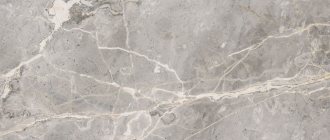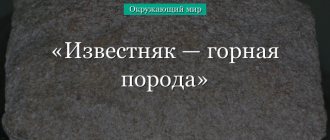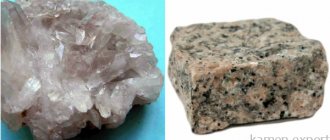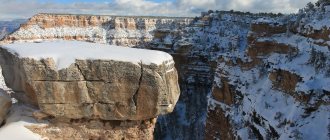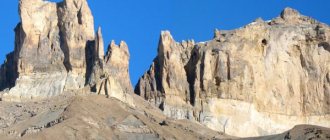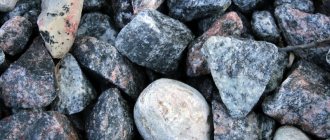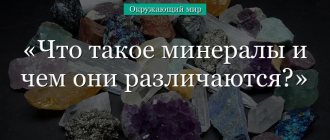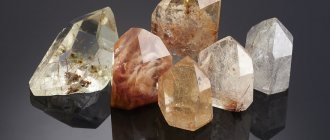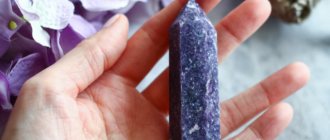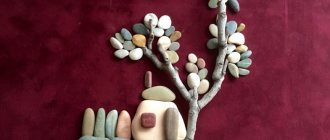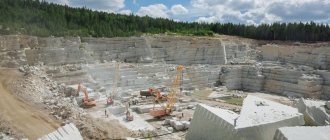Granite is a rock formed in the depths of the Earth. When hot magma reaches the surface, a volcanic eruption begins. If the molten mass has not made its way up, a geological body of solidified magma is formed at depth. There are several varieties of deep rocks, one of them is granite.
Quartz
In granites, quartz is the hardest mineral; it is found very rarely in the form of crystals; it usually forms white, gray grains of irregular shape. Regular crystals form in voids (inside vein bodies).
Quartz crystals are shaped like hexagonal columns with a beveled top. Its colored varieties have their own names. Colorless crystals are called rock crystal, purple crystals of all shades are called amethyst, honey crystals are called citrine, smoky crystals are called rauchtopaz, black crystals are called morion.
Rice. 1. Intergrowth of amethyst crystals.
Experts grow artificial quartz, which is no different in properties from natural quartz.
In the Urals at the beginning of the twentieth century there was a mountain (Crystal Mountain), consisting of white dense quartz. Quartz mining began in the 1930s, and the quarry is still in operation.
Natural as “white stone”
The elements destroy igneous rocks, turning them into loose clastic deposits (sands, clays, gravels, crushed stone, pebbles, boulders), and then into cemented ones (sandstones, breccias, conglomerates). The world's oceans give land all kinds of chemical precipitation (gypsum stone, dolomite, anhydrite). Limestones, diatomites, chalk, tripoli are of organic origin; they are monuments of once living plants and animal organisms. All sedimentary rocks in one way or another “work” for the construction industry, but I would like to say especially about two of them. Limestone. Tourists are taken to the white stone churches of Vladimir-Suzdal Rus' of the 12th-13th centuries. The cult carving amazes not so much with the semi-pagan nature of the motifs, but with its whiteness and indestructibility. Unfortunately, there is little such material left these days. Deposits near Moscow produce soft stone that peels off in your hands. Limestone imported from Abkhazia is stronger and denser (2200 kg/m3). It is suitable for cladding; perfectly white slabs with torn edges and a bumpy surface look very impressive. Pulkovo stone (2600 kg/m3) is used for masonry - yellowish, brownish blocks, bars with a “fur coat” texture, as well as slabs with sawn edges and a “rock” texture. As for color, there is no mistake here. Limestone is called “white stone” because its composition is dominated by calcites, and, as a rule, it is really white, but depending on the impurities it has shades. The structure varies: granular-crystalline, dense, shell rock, breccia. Textures: homogeneous massive, layered, banded, spotted, porous. In terms of water absorption, dense limestones compete with other granites (from 0.1%), and loose limestones retain up to 30% of moisture. By the way, due to the tense relationship with water and chemicals, no limestone should be used for laying foundations. The range of compressive strength is huge - from 0.12 to 135 MPa (usually 30 MPa); the same thing with frost resistance: there is a material that tolerates only 15 cycles, but there is also one that is frozen and thawed up to 150 times. In the conditions of a modern polluted city, limestone cladding suffers greatly. After 10-20 years of use, traces of significant destruction may appear and whiteness may be lost. To protect the stone, special chemical surface treatment is carried out. When interlayering sandstone with other rocks, it is necessary to take into account their porosity: migration of salt-bearing solutions may occur to where it is larger, and as a result, destruction. In particular, sandstone cannot be interlayered with limestone. By the way, the properties of the rock are in many ways similar to marble. Water absorption, frost resistance, and hardness are almost the same. Sandstone is inferior in strength, but whether marble wins in terms of decorativeness is a philosophical question. It all depends on the goals of the architect. The structure of the stone is granular, textures can be uniform, layered, banded and spotted. The color of the stone ranges from white-yellow, fawn, greenish and gray with a hint of blue. Unlike marble, sandstone is not polished; the more natural it is, the more beautiful it is.
Mica
The softest mineral in granite. It is observed in the form of thin plates of black or dark brown color. Some varieties of granite contain gray mica muscovite.
Mica crystals are thin-plate hexagonal columns. With a sharp knife you can split them into separate almost transparent plates.
Until the 13th century, there was no window glass yet; muscovite plates were used in rich houses. The binding was made of lead.
Rice. 2. Mica window.
As beautiful as marble
Time, exposure to temperature and pressure, and the chemical activity of various solutions have produced significant metamorphoses in the stone. Igneous rocks, having changed their structure and mineral composition, were transformed into less durable, less decorative, finding the most prosaic uses, for example, as raw materials for crushed stone. Sedimentary materials rather improved their properties, turning into quartzites, slates and marbles - noble, beautiful, inspiring artists of all stripes to create masterpieces. Quartzites have high compressive strength of 100-450 MPa, acid and fire resistance (hold up to 1770° C). This is a decorative finishing stone and at the same time a raw material for the production of material from which industrial furnaces are made. Shales are characterized by an oriented arrangement of rock-forming minerals and are capable of splitting into thin plates, convenient for use in finishing. They surprise with their variety of shades, fascinate with their matte shine, and attract with properties unique to stone. Floors laid with metamorphic slates are non-slip and warm, it is pleasant to walk on them barefoot (the material has a high resistance to heat transfer). Well, even the name of marble speaks for itself: marmaros translated from Greek means “shiny stone.” He is brilliant in every sense. Firstly, due to its low hardness, it is superbly polished and really shines. Secondly, its mineral composition, in addition to calcite and dolomite, sometimes contains quartz and pyrite, which add the radiance of crystal and “gold” to the overall shine. Thirdly, the richness of textures and a colossal color palette allow you to bring to life the most brilliant interior ideas.
Density of marble – 1980-2900 kg/m3; water absorption - up to 10% (although there are varieties that absorb only 0.06% of moisture); compressive strength on average 70-300 MPa; natural wear – less than 0.6 mm; frost resistance – 15-150 freeze-thaw cycles. Slates and marbles come from limestones, hence the general instability to acids, food dyes, and relative softness. You should not make a kitchen countertop ; this stone is not for the kitchen, but for the state rooms. Paving is only advisable in areas with low traffic volume. For example, in the hall of a private mansion you can lay the floor with marble slabs, but not in a theater foyer or store. Stone with a rich texture, interspersed with mica and other minerals is left for cladding walls, fireplaces, window sills , and when laying floors, preference is given to varieties without foreign inclusions. You need to be careful when using mosaic paving while using harder rocks, as after some time the floor will become uneven due to uneven abrasion. It is interesting that marble can present a “surprise”. For example, sometimes a completely white stone, after wet cleaning, suddenly becomes saturated with yellowness - this makes itself known as an admixture of iron. Some green varieties turn gray when exposed to direct sunlight for a long time. To be on the safe side and protect natural stone products from harmful influences, it is recommended to treat them with special chemicals. Some compositions penetrate to a certain depth, filling the pores, while others form a thin protective film on the surface. There are also special mastics of various colors for treating cracks and cavities. We must remember: any shortcomings of the material can be compensated for by its correct use and proper care.
Use of granite and its minerals
Granite and its components are used in various industries.
Quartz is a raw material for the production of ordinary and fire-resistant glass, water filters, and is used in metallurgy, mechanical engineering, electrical engineering and electronics. In the form of natural crystals and faceted stones, it is inserted into jewelry.
Feldspar is necessary for the manufacture of ceramics, rubber products, toothpaste, and is needed in mechanical engineering and electrical engineering.
Mica is used in the production of paints and electrical insulation.
Solid blocks of granite serve as the basis for monuments, for example, the base of the “Bronze Horseman”. The cladding of subway walls, city stairs, building facades is polished granite slabs. Granite crushed stone is in demand for backfilling road bases.
Rice. 3. The Bronze Horseman.
As solid as basalt
The earth even now has a rather cool temperament, but in ancient times it was generally seething with passions, throwing “emotions” to the surface every day. Basalts, trachytes, liparites, as well as diabases and porphyries are nothing more than traces of ancient volcanic eruptions. In fact, igneous rocks are “relatives” of the deep ones, but they were formed under different conditions. Porphyries and trachytes are beautifully colored and consist of feldspar crystals unevenly scattered in a fine-grained or glassy sequence. Their density and hardness are like marble, they are well processed, and therefore are used as finishing and ornamental materials.
Basalts and diabases, on the contrary, have high density (2800-3200 and 2600-3100 kg/m3, respectively) and hardness comparable to “granite”. The color scheme is modest. Basalt is dark gray and black; in diabase it is dark gray and greenish. The main areas of application are rubble masonry foundations, walls of unheated premises, retaining walls, paving. Paving stones are much more environmentally friendly than asphalt concrete and, unlike it, literally have no drift: less than 0.6 mm is removed from the pavement on Red Square by a million people per year.
What have we learned?
Granite is a deep-seated rock consisting of quartz, feldspar and mica. The components of granite are used in various fields: in the production of glass and ceramics, paints, rubber products, and for decorative works. A description of granite and its minerals can be included in a report for 2nd grade children for a lesson on the world around them.
Previous
The world around usWinter phenomena in inanimate nature - brief examples (Grade 2, the world around us)
Next
The world around us Ferns - characteristics of a plant for a report or message (grade 3, world around us)
Mineralogical composition
Sometimes people have confusion and they cannot understand whether granite is a mineral or a rock. Of course, the second one. Many have paid attention to its granular structure, and it definitely does not consist of one substance. Many people remember from school natural history lessons what minerals are part of granite. This is first of all:
feldspar;- quartz;
- mica.
Gneiss also consists of a similar set - that which is obtained from granite through metamorphism.
Gneiss and granite have almost identical mineral composition formulas, only the structure differs.
Feldspars
These are silicate crystalline compounds, which can be found in the earth’s crust up to 50%, most of them in the composition of other rocks. They do not have a single formula, and they are divided into categories based on the presence of certain metal atoms in the crystal lattice. Based on this feature, plagioclases, potassium and potassium-barium feldspars are distinguished . The plagioclase group includes:
- albite NaAlSi₃O₈;
- oligoclase CaAl₂Si₂O₈ and NaAlSi₃O₈ in a ratio of 3:7;
- andesine with the same composition in a 1:1 ratio;
- Labrador, the composition is the same, the proportion is 7:3;
- bitovnit, 9:1;
- anorthite, pure CaAl₂Si₂O₈.
In igneous rocks, plagioclases are the first to form crystal lattices, and are often what make up the majority of the rock. Potassium feldspars are less diverse in chemical composition; they have the same formula - KAlSi₃O₈. The diversity lies in the structure of the crystal lattice, and it produces the following minerals in different modifications:
- orthoclase;
- adularia (moonstone);
- microcline;
- Sanidine
Potassium feldspars are more stable than plagioclases, but like them, they become clay under the influence of erosion. By replacing some potassium atoms with barium, potassium-barium spars are obtained, but this is a rare phenomenon.
These minerals make up from 60 to 65% of granite, and the color of this rock depends on them. Plagioclases give the stone a gray color, while potassium compounds give it a pink color. Yellow, green and blue colors are given to the stone by both foreign inclusions and metal cations in spars - sodium, potassium, calcium, magnesium and other metals in them are interchangeable.
What is it like?
Based on the size of the grains, the following types of granite can be distinguished, namely:
- coarse-grained stone (over 10 mm);
- medium-grained granite (2-10 mm);
- fine-grained (less than 2 mm).
The color palette of granite is represented by almost the entire spectrum of shades. The multi-colored grains are feldspar, mica colors granite black, and quartz is responsible for the sparkling translucent grains.
External differences between granite and marble
Some types of granite and marble can be quite difficult to distinguish externally, due to the fact that some types have a pattern, color or texture uncharacteristic for the rock; blue, gray and white types are most often confused. Some people mistakenly believe that marble is only light in color, due to the persistent image of antique statues and columns made of white stone; in fact, the color palette of marble stone is quite wide and includes the entire color spectrum from snow-white to charcoal black.
The texture of marble is quite recognizable; this mineral can be distinguished by characteristic veins of stone veins that differ from the main color: on white, these can be small gray or black veins, on gray or black, dense networks of white or cream shades.
The texture of granite resembles clusters of multi-colored grains; the only exceptions are rare types of elite colored species, which can be monochromatic or contain small color stains. To understand what granite looks like, take a closer look at city underground passages and embankments; as a rule, granite tiles are used for such purposes.
History of the use of mica in industrial areas
The first cases of the use of this mineral, mainly instead of window glass, were attested in Novgorod (X-XII centuries) during the period of development of the riches of Karelia and the Kola Peninsula in this territory. Then Ivan the Terrible conquered Novgorod and Pskov, which contributed to the acquaintance of the Moscow rulers with mica.
At the beginning of the seventeenth century, the mica industry was already quite widely developed in Karelia. According to official data, by the beginning of 1608 there was a Decree of the Moscow government regarding the collection of taxes from the mined mineral in the amount of one tenth of the total volume.
The development and exploration of Siberia led in the 17th century to new discoveries of mica deposits. Its presence was attested by Vladimir Atlasov in 1683 on Aldan. These deposits were subsequently forgotten, and only two hundred and fifty years later (on the eve of the Great Patriotic War) were rediscovered. At that time, the exploitation of mica began primarily for the needs of the country's defense.
Interpretation of the concept
This group of minerals has perfect cleavage in one direction. They are capable of splitting into very thin hard plates, while maintaining elasticity, flexibility and strength.
Thus, we can conclude that mica is a mineral that visually resembles glass and has a structure of layered crystals. It is due to this feature, as well as due to the weak connection between individual packages of materials, that certain chemical properties are formed.
Regardless of the fact that there are many varieties of the mineral in question, it has common characteristics, such as:
- lamellarity;
- basal cleavage;
- the ability to split into the finest components.
Its virtues
Granite is a stone whose mica content makes it durable compared to the popular marble. Products made from it never lose their properties and are not externally deformed when used in a climate with a continental seasonal temperature difference of more than one hundred degrees. Thus, granite is not afraid of either sixty-degree frosts or heat above 50 degrees, which is important in the Russian climate. In addition, this stone is much less susceptible to fungal infections than marble.
Granite, which contains mica in the form of muscovite and biotite, is not only durable, but also a fireproof stone. It begins to melt at temperatures above 700 degrees Celsius.
You should also consider a criterion that determines the degree of strength, such as moisture absorption. Granite outperforms all its competitors.
